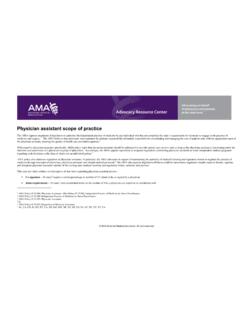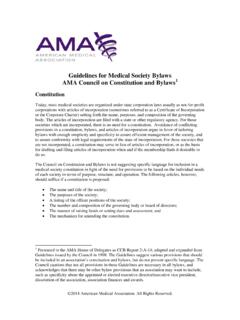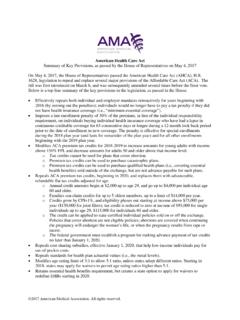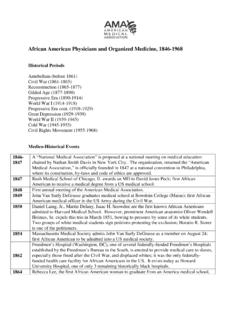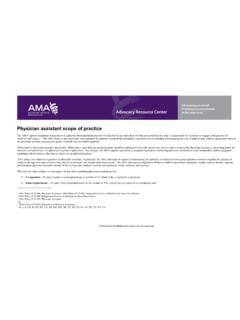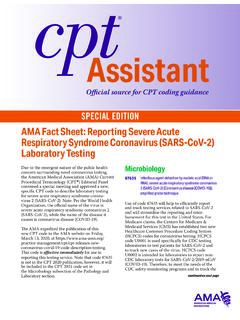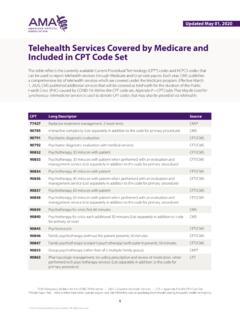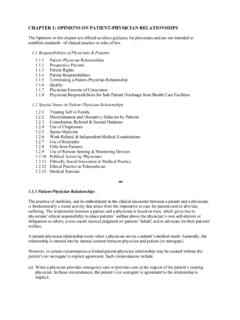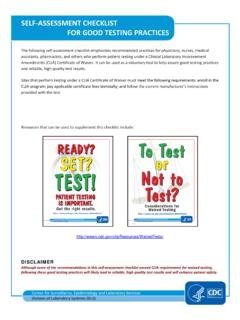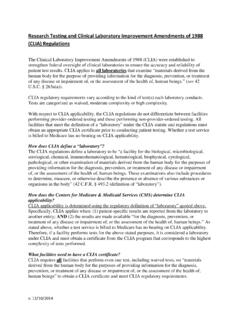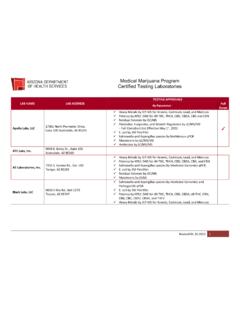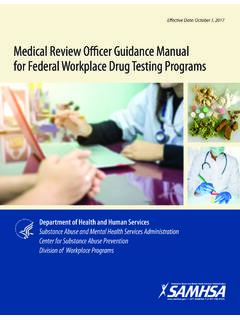Transcription of Assistant - American Medical Association
1 SARS-CoV-2 Serologic laboratory TestingAs the coronavirus (COVID-19) pandemic con-tinues and as responses to the disease evolve, the American Medical Association (AMA) Current Procedural Terminology (CPT ) Editorial Panel convened a second special meeting within a month to approve codes specific to laboratory testing for severe acute respiratory syndrome coronavirus 2 (SARS-CoV-2) (coronavirus disease [COVID-19]). To address the urgent clinical need to report (and track) antibody testing , the CPT Editorial Panel has revised one code and established two additional codes to provide increased specificity to report sero-logic laboratory testing .
2 The AMA expedited the publication of these changes to the AMA website on Friday, April 10, 2020, at In addition to the revision of code 86318, addition of the two new codes, and a guideline revision, three parenthet-ical notes have been added to provide guidance on selecting the most appropriate code for the procedure performed. These codes are effective immediately for use in reporting these laboratory tests. Note that the revised code 86318, two new codes 86328 and 86769, new parenthetical notes and revised guideline are not included in the CPT 2020 code set; however, they will be included in the CPT 2021 code set in the Immunology subsection of the Pathology and laboratory section.
3 Immunologys86318 Immunoassay for infectious agent antibody(ies), qualitative or semiquantitative, single step method (eg, reagent strip);#I86328 severe acute respiratory syndrome coronavirus 2 (SARS-CoV-2) (Coronavirus disease [COVID-19]) c(For severe acute respiratory syndrome coronavirus 2 [SARS-CoV-2] [Coronavirus disease {COVID-19}] antibody testing using multiple-step method, use 86769)bI86769 Antibody; severe acute respiratory syndrome coronavirus 2 (SARS-CoV-2) (Coronavirus disease [COVID-19]) c(For severe acute respiratory syndrome coronavirus 2 [SARS-CoV-2] [Coronavirus AssistantOfficial source for CPT coding guidanceAMERICAN Medical ASSOCIATIONSPECIAL EDITION: April Updatecontinued on next page2 CPT Assistant Special Edition: April Update / Volume 30 2020disease {COVID-19}] antibody testing using single step method, use 86328)bThe new codes will allow accurate reporting and tracking of tests performed specifically for COVID-19 caused by SARS-CoV-2.
4 Code 86328 was established as a child code to 86318 to report a qualitative or semiquantitative single-step method immunoassay for SARS-CoV-2 (COVID-19) antibody(ies). Code 86769 was established to report an antibody test for SARS-CoV-2 (Coronavirus disease [COVID-19]) using a multiple-step method. Note that code 86769 will be a child code under parent code 86710. It is represented here in its entirety, ie, complete long descriptor, including the language from parent code following information from the code set shows additional changes made to the code set related to the new antibody codes. The guidelines for codes 86602-86804 have been revised to incorporate new code 86328.
5 In addition, a parenthetical note has been added following code 86635 directing users to new codes 86328 and following codes (86602-86804) are qualitative or semiquantitative immunoassays performed by multiple-step methods for the detection of anti-bodies to infectious agents. For immunoassays by single-step method (eg, reagent strips), see codes 86318, 86328. Procedures for the identification of antibodies should be coded as precisely as possible. For example, an antibody to a virus could be coded with increasing specificity for virus, family, genus, species, or type. In some cases, further precision may be added to codes by specifying the class of immunoglobulin being detected.
6 When multiple tests are done to detect antibodies to organisms classified more precisely than the specificity allowed by available codes, it is appropriate to code each as a separate service. For example, a test for antibody to an enterovirus is coded as 86658. Coxsackie viruses are enteroviruses, but there are no codes for the individual species of enterovirus. If assays are per-formed for antibodies to coxsackie A and B species, each assay should be separately coded. Similarly, if multiple assays are performed for antibodies of different immunoglobulin classes, each assay should be coded separately. When a coding option exists for reporting IgM specific antibodies (eg, 86632), the corresponding nonspecific code (eg, 86631) may be reported for performance of either an antibody analysis not specific for a particular immunoglob-ulin class or for an IgG 86635 (For the detection of antibodies other than those to infectious agents, see specific antibody [eg, 86021-86023, 86376, 86800, 86850-86870] or specific method [eg, 83516, 86255, 86256]).
7 (For infectious agent/antigen detection, see 87260-87899)Antibody; actinomyces Coccidioidesc(For severe acute respiratory syndrome coronavirus 2 [SARS-CoV-2] [Coronavirus disease {COVID-19}] antibody testing , see 86328, 86769)bThe following clinical examples and procedural descriptions reflect typical clinical situations for which these new codes would be appropriately reported. Due to the early utilization stage for these tests, clinical indications are subject to further refinement as knowledge of the novel coronavirus evolves. The CPT Editorial Panel will continue to review and may clarify these indications as more information becomes Example (86328)A 67-year-old female with a history of diabetes mel-litus and hypertension presented to the emergency department with a 5-day history of malaise, a non-productive cough, and low-grade fever (eg, F/ 38 C).
8 A SARS-CoV-2 IgG/IgM reagent strip anti-body test for COVID-19 was ordered. Blood or serum is collected from the patient for of Procedure (86328)A reagent strip cartridge coated with anti-human monoclonal IgM and IgG antibodies and goat anti-mouse IgG antibodies is removed from its sealed container. The patient s blood sample is added to the specimen well, followed by specimen diluent. After the specimen and reagents advance to and react with the test area of the reagent strip, the specimen is read optically, observing the control, IgG and IgM bands. Results are interpreted and Example (86769)A 68-year-old male with a history of coronary artery disease, aortic valve replacement, and lym-phoma presented to the emergency department CPT Assistant Special Edition: April Update / Volume 30 20203with a 6-day history of malaise, a non-productive cough, and low-grade fever (eg, F/38 C).
9 SARS-CoV-2 IgG and IgM antibody tests were ordered to inform diagnosis of acute or conva-lescent phase of COVID-19. Serum or plasma is collected from the patient for of Procedure (86769)A sample of the patient s serum or plasma is diluted in buffer and an aliquot of the diluted sample and controls in duplicate are added to a multi-well plate, incubated and washed. Peroxidase-conjugated mouse anti-human IgG and IgM antibodies are added to the sample plate and incubated. A chromogenic substrate is added, incubated, and immediately read at 450 nm using a microtiter plate reader. Results are interpreted and following are a few common questions and answers regarding these new SARS-CoV-2 (COVID-19) te : When are these codes available for reporting?
10 Answer: Codes 86328 and 86769 are available for reporting beginning April 10, 2020. Contact your third-party payer to determine their guidelines regarding : How do these tests differ from newly released code 87635 for laboratory testing for SARS-CoV-2?Answer: Code 87635 is reported for respiratory specimens from which DNA/RNA is obtained and analyzed, and it is designed to detect the SARS-CoV-2 virus. The two new serologic codes will be used to identify the presence of antibodies to the SARS-CoV-2 : I am using a standalone device that tests for SARS-CoV-2 IgM and IgG antibodies at the point of care (POCT), which new code should I report?
